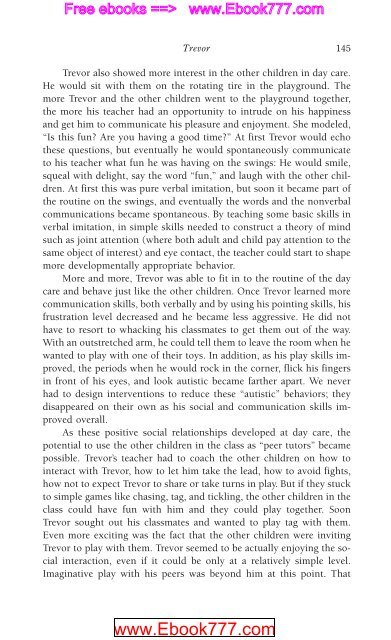978-1572305441
autism
autism
You also want an ePaper? Increase the reach of your titles
YUMPU automatically turns print PDFs into web optimized ePapers that Google loves.
Free ebooks ==> www.Ebook777.com<br />
www.Ebook777.com<br />
Trevor 145<br />
Trevor also showed more interest in the other children in day care.<br />
He would sit with them on the rotating tire in the playground. The<br />
more Trevor and the other children went to the playground together,<br />
the more his teacher had an opportunity to intrude on his happiness<br />
and get him to communicate his pleasure and enjoyment. She modeled,<br />
“Is this fun? Are you having a good time?” At first Trevor would echo<br />
these questions, but eventually he would spontaneously communicate<br />
to his teacher what fun he was having on the swings: He would smile,<br />
squeal with delight, say the word “fun,” and laugh with the other children.<br />
At first this was pure verbal imitation, but soon it became part of<br />
the routine on the swings, and eventually the words and the nonverbal<br />
communications became spontaneous. By teaching some basic skills in<br />
verbal imitation, in simple skills needed to construct a theory of mind<br />
such as joint attention (where both adult and child pay attention to the<br />
same object of interest) and eye contact, the teacher could start to shape<br />
more developmentally appropriate behavior.<br />
More and more, Trevor was able to fit in to the routine of the day<br />
care and behave just like the other children. Once Trevor learned more<br />
communication skills, both verbally and by using his pointing skills, his<br />
frustration level decreased and he became less aggressive. He did not<br />
have to resort to whacking his classmates to get them out of the way.<br />
With an outstretched arm, he could tell them to leave the room when he<br />
wanted to play with one of their toys. In addition, as his play skills improved,<br />
the periods when he would rock in the corner, flick his fingers<br />
in front of his eyes, and look autistic became farther apart. We never<br />
had to design interventions to reduce these “autistic” behaviors; they<br />
disappeared on their own as his social and communication skills improved<br />
overall.<br />
As these positive social relationships developed at day care, the<br />
potential to use the other children in the class as “peer tutors” became<br />
possible. Trevor’s teacher had to coach the other children on how to<br />
interact with Trevor, how to let him take the lead, how to avoid fights,<br />
how not to expect Trevor to share or take turns in play. But if they stuck<br />
to simple games like chasing, tag, and tickling, the other children in the<br />
class could have fun with him and they could play together. Soon<br />
Trevor sought out his classmates and wanted to play tag with them.<br />
Even more exciting was the fact that the other children were inviting<br />
Trevor to play with them. Trevor seemed to be actually enjoying the social<br />
interaction, even if it could be only at a relatively simple level.<br />
Imaginative play with his peers was beyond him at this point. That



